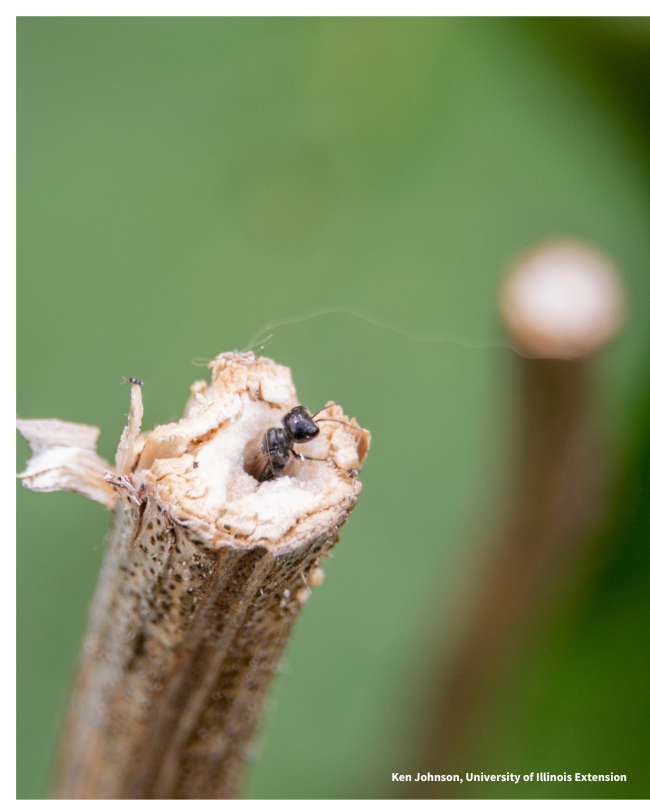
As the days get longer and the temperatures start to warm, we often get the itch to start gardening. On the first warm day of the year, I often find myself thinking I need to be doing something in the garden because it’s so nice out. However, we shouldn’t be in too big of a hurry to start cleaning up our gardens in preparation for the upcoming growing season.
While cutting back dead plants and removing leaves and debris from garden beds can make for a clean-looking landscape, it may not be the best thing for pollinators and other wildlife inhabiting our landscapes. So, how should we approach garden cleanup in the spring?
Why should I care about cleaning up too early?
While monarchs and some species of birds will migrate south for the winter, most of our pollinators and other wildlife will stick around, often in plant debris. Many species of moths and butterflies, like the mourning cloak butterfly, swallowtails, and luna moths, will overwinter in leaves. Bumble bee queens may also utilize leaves to overwinter. Others, like leafcutter and mason bees, may use old flower stalks as nests where their offspring will overwinter.
By cleaning up plant debris, we are getting rid of these overwintering areas and the insects that may be inhabiting them. Leaving plant debris where it is for as long as possible will give overwintering pollinators and beneficial insects time to emerge.
When can I start spring clean up?
Try to hold off the urge to clean up your landscape during March and early April, no matter how nice the weather gets. In the northern and midwestern parts of the US, the earliest we should consider cleaning up our landscapes is around mid-April (you can spend your newfound free time working on your taxes). By this time, many insects will have emerged from overwintering. However, not all will have.
Ideally, we would wait until low temperatures are reliably in the 50s (Fahrenheit) or when we would start planting tomatoes. This is usually around mid-May. The soil should be sufficiently warm by this time, and overwintering insects should have emerged for the year.
Cleaning up the landscape
If you feel like you need to start your landscape cleanup early, start by tidying up highly visible areas, such as your front yard, and leave more hidden or out-of-the-way places alone until later in the spring.
When cleaning up early, pile plant debris loosely in an out-of-the-way area. Don’t make the piles so big that the plant material starts to compress, or place the material in the compost pile (yet). Piling it loosely will give any overwintering insects a chance to emerge, whereas large piles may trap insects. Once we reach mid-May and all overwintering insects have emerged, you can compost or dispose of the material.
One thing you can do earlier in the spring is to prune old flower stalks. Various bees will utilize old flower stalks of plants, such as bee balm, blazingstar, coneflower, and goldenrod, to build their nests. Pruning these plants earlier in the spring will ensure they are available for pollinators to use when they emerge.
When pruning, leave 8-24 inches of the stalk behind. This will leave behind stems of varying diameters for pollinators to utilize. If you are concerned that leaving the stalks behind will be too unsightly, once the plants begin to grow, they will quickly cover up and hide any stalks you leave behind.
The eggs that are laid in the stalks will hatch and develop during the growing season. These bees will then overwinter in the stalks before emerging the following year.
Instead of being in a hurry to get your landscape cleaned up before the growing season kicks into high gear, take some time to enjoy the sights of spring and stop and smell the flowers.
Good Growing tip of the week: You can take the tops of the flowers you prune, bundle them together, and place them in a sheltered place to create additional nesting habitat for pollinators.
Signup for our emails! Want to get notified when new Good Growing posts are available? SIGN ME UP
MEET THE AUTHOR
Ken Johnson is a Horticulture Educator with University of Illinois Extension, serving Calhoun, Cass, Greene, Morgan, and Scott counties since 2013. Ken provides horticulture programming with an emphasis on fruit and vegetable production, pest management, and beneficial insects. Through his programming, he aims to increase backyard food production and foster a greater appreciation of insects.
